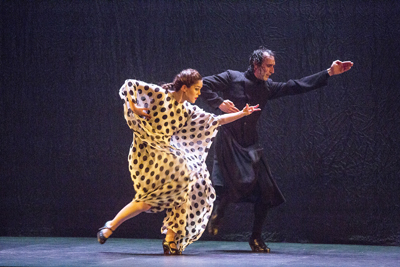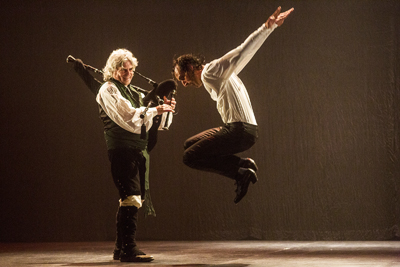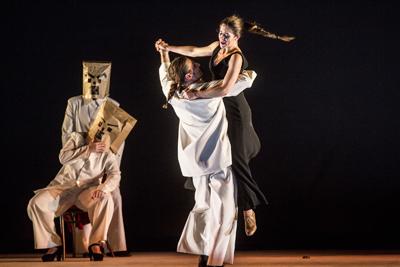Dance: Flamenco Master and Student Make Their Mark at the 2019 Jerez Festival
By Justine Espoz Bayod
arttimesjournal June 19, 2019
The XXIII edition of the Jerez Festival - the de rigueur annual event for flamenco and Spanish dance held in Jerez de la Frontera, Spain - got off to a slow start with a slew of high concept shows that were low on compelling dance. It was not a good look for a festival that prides itself on presenting the best of Spanish and Flamenco dance over 16 days between February and March. Looking back now, it wasn't until 11 days in that there was anything truly worthy of reporting, but the two shows that graced municipal Villamarta Theater's stage on March 4 and 5, deserve remembering.
Awarded Spain's highest dance honour in 2015, the National Dance Prize, the Seville-born Ruben Olmo is as accomplished a dancer and choreographer as they come. He's danced as a soloist with the National Ballet of Spain and later joined Eva la Yerbabuena's company. He went on to create two works with his eponymously named company before he was named the Artistic Director of the Flamenco Ballet of Andalusia in 2011 for a two-year tenure, and where he created two works for the ballet. More recently, Olmo has worked as a teacher at the Andalusian Dance Center, while collaborating on choreographies for other companies, including that of Victor Ullate.
 Ruben Olmo dances a duet with Patricia Guerrero in his show Horas Contigo. Photo by Javier Fergo, Photo courtesy of the Festival de Jerez |
Olmo presented Horas Contigo (Hours with You) at the festival, resuscitating his company after a nearly four-year hiatus, and the comeback couldn't have been stronger. The company's reintroduction is kept simple with a "best-of Rubén Olmo" approach that combines favorite works from previous shows, as well as a couple of new pieces created in collaboration with dancer/choreographer's Patricia Guerrero and Eduardo Leal, both of whom have studied and worked under Olmo.
Olmo is thin and lithe, and his impressively precise sissonnes, leaps and cabrioles - for which he is well known - have always given him a more classical bent. Horas Contigo starts in the vein to which audiences have grown accustomed with Olmo, that wonderful linear legwork, the graceful arms and turns, jumps that somehow defy gravity, but he quickly transitions into a curved, heavy, percussive flamenco dancer.
Olmo's classical technique and physique seem to have played a bigger role in defining his style and career, but if the first part of Horas Contigo does anything, it reminds us that Olmo's flamenco choreography and execution are on point and will not be overshadowed. He starts with traditional flamenco - choreographies that are jovial yet intense and that showcase his tremendous footwork - but then moves into the contemporary with the now legendary piece Falsa Farruca, which was choreographed for Olmo by Israel Galván.
 Ruben Olmo performs "Falsa Farruca," choreographed by Israel Galvan, in his show Horas Contigo at the Jerez Festival. Photo by Javier Fergo, courtesy of the Jerez Festival |
The Farruca is a somber, highly masculine flamenco style that is rumored to have begun in Galicia, Spain's Northwestern-most autonomous community on the opposite end of the country from Andalusia, flamenco's birthplace. In this "False Farruca," Olmo walks out on stage with a bagpipe player (an instrument typical of traditional Galician music) and they discuss the possibility of performing a farruca as though it really was from Galicia. The result is a tongue-in-cheek work of genius that combines bagpipe music and flamenco dance with aspects of folkloric Galician dance and some of Israel Galvan's signature whip-like, angular movements. It's a hodgepodge that is meant to be both humorous, reflective and entirely unique.
Horas Contigo is a successful production because each piece is a completely different style and tone, and the audience is treated to Olmo's wide-ranging dominion of Spanish dance, including escuela bolera (a classical style of dance from the XVIII century) and Classical Spanish. However, the production's most laudable quality is that it radiates love.
Olmo dances each piece with a palpable affection, and his duets with Guerrero and Leal are evenhanded, with the master showing deference to his students. In turn, these acolytes have created works that use dance to extol mutual respect and admiration of Olmo. The audience feels privileged to witness these seemingly intensely personal interactions and to review a dance career that truly is worth a second look. For his efforts, Olmo was awarded the much deserved festival's Critic's Prize.
Flamenco is an art form in continuous evolution, and while some artists are happy to respect and propagate the tradition, others strive to create a contemporary language that makes them unique and cutting edge. The race for innovation is often unsuccessful, either because the flamenco itself becomes too muted or because the work becomes conceptually muddled.
It's rare to see a contemporary flamenco piece that manages to truly exalt the art form, while also breaking traditional barriers. Yet, one night after dancing a duet with Olmo on the Villamarta stage, Granada-born dancer and choreographer Patricia Guerrero, managed to do just that with her work Dystopia.
Guerrero's 2017 performance at the Jerez Festival, Cathedral, was a bold and eccentric take on femininity within the context of the ecclesiastical, taking into account both the sacred and the profane. Dystopia is no less bold or eccentric or even feminist. As the program notes explain, "we are shown a woman within a society that by all appearances is kind but that in reality imprisons this woman and strips her of her true self and almost of her own body in order to change her into a kind of automaton with a predetermined path."
Guerrero is one of the great new flamenco promises. Her dance style is entirely nonconformist, yet her technique is pristine. She is well known for her agility and lightning speed footwork, which despite being furious - sometimes to the point of frenzy - somehow manages to remain crisp and in perfect rhythm.
As so many young flamenco dancers do, she favors angular, stiff upper body movements, but unlike her contemporaries' experiments with more jerky, mechanical or spastic hand and arm gestures. There is a certain level of awkwardness to her current aesthetic that produces a kind of offbeat beauty.
Despite giving us a taste of a yet-evolving Guerrero, Dystopia, is most notable for being one of those rare productions that use fusion to fantastic effect. The production's music ranges from traditional flamenco to contemporary to classical, and the choreography doesn't fuse different dance styles so much as it presents them side by side.
 Patricia Guerrero dances with Ángel Fariña in her production Dystopia. Photo by Javier Fergo, courtesy of the Jerez Festival. |
Guerrero includes two other dancers, phenomenal flamenco dancer Ángel Fariña and urban dancer Rodrigo García Castillo and unifies their dance with an overarching contemporary approach to the choreography as a whole. In other words, Guerrero and Fariña dance flamenco, García Castillo dances elements of hip hop, pop and break dance, and their styles are blended together with shared contemporary dance elements. It may sound like an arbitrary recipe for disaster, but it's a mashup that works, and more importantly, it intrigues.
The success of Dystopia is in no small part also attributable to the stage direction and dramaturgy of Juan Dolores Caballero. From its intense color palate of red, black and white to its clean, minimalist set that played with light and shadow to its use of costuming to juxtapose the traditional and the contemporary, the work is an unwavering visual delight.
The show uses a series of leitmotifs to unite the choreographies and show
the protagonist's progression. The ticking of a metronome references the
passing of time, broad shoulder posturing and the bowed, flexed arms common
to bodybuilders represent masculine strength and power, and the sometimes faceless male figure, embodied by Fariña, leads
Guerrero in multiple duets that block, guide or beguile her. The complexity
in the meaning behind the work means that its messaging is not overt and
easily unraveled, but its dramatic intentions are pretty clear and provide
great fodder for interpretation.
